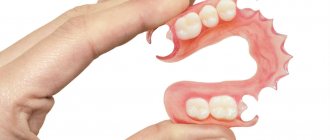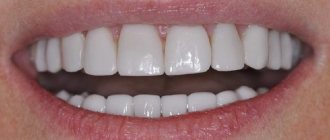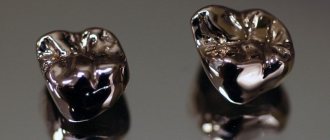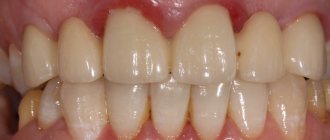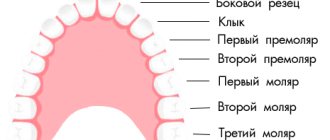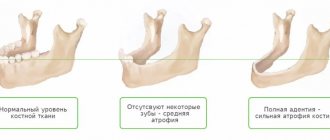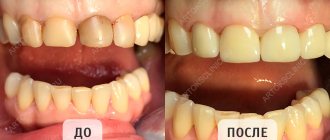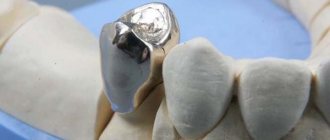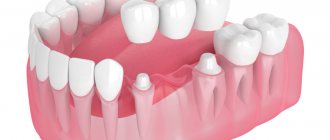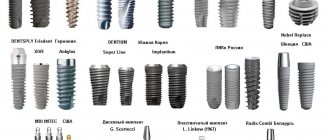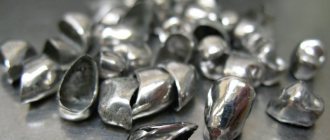In the lateral sections, teeth (molars, premolars) are subject to regular high loads, while their anatomical structure and location in the dentition makes care more difficult. Therefore, chewing units are destroyed faster due to various injuries and dental diseases. Prosthetics of molars and premolars involves the use of structures made of durable, reliable materials that are resistant to severe chewing loads. Dental crowns are orthopedic structures for single restorations, indicated when the upper part of the tooth is destroyed by more than 60%, when the installation of a filling is ineffective.
Structural materials in prosthetics
A modern dentist has a sufficient amount of materials for making dentures in his arsenal.
In modern prosthetics, materials such as: Plastic are used. Used for the manufacture of temporary crowns, and removable acrylic and nylon structures. Plastic products do not last long, so they will need to be replaced after a while.
Metal. Gold-containing and cobalt-chromium alloys are widely used. Metal crown frames and clasp dentures are very common.
Zirconium. Zirconium oxide and dioxide are ideal materials for restoring dentition in the chewing area. The ceramic coating of zirconium crowns gives the product a natural shine.
Ceramics. This material is valued for its properties that are as close as possible to natural tooth enamel. For ceramic products, you can easily choose the desired shade. The main disadvantage of ceramics was previously considered to be low strength, but with the beginning of the use of sodium disilicate in prosthetics, this parameter improved. A good example of the use of ceramics is E-Max crowns.
Which dental prosthetics is better and cheaper is a question that only his attending physician can answer for each patient. Much depends on the location of installation - anterior or chewing teeth, the level of qualifications of the specialist and the nuances of a specific clinical situation.
The best crowns for chewing teeth
Since the main requirements for prosthetics of molars and premolars are the strength and durability of orthopedic systems, the best crowns for chewing teeth are made of zirconium or metal-ceramics. Zirconium is the most durable, lightweight material; installation of such structures requires minimal preparation of the abutment tooth, which is a big advantage over metal-ceramic products. The doctor will decide which restoration to use in a particular case after a detailed assessment of the clinical picture, the characteristics of the patient’s body, his wishes and financial capabilities.
How much do crowns cost in Moscow?
The cost of treatment depends on the complexity of the case, the volume of intervention, restoration material, and manufacturing technology. Installation of metal crowns in Moscow costs on average from 10,000 rubles. per unit, metal ceramics will cost from 15,000 rubles, and a zirconium dioxide crown – from 30,000 rubles.
The ILATAN clinic operates a case payment system, which protects the patient from unexpected expenses and hidden fees. The turnkey price includes all necessary measures for tooth restoration - from consultation to manufacturing and installation of a crown. Treatment of teeth, gums, production and installation of a core inlay, dismantling of old restorations are paid separately. The doctor will announce the exact amount of treatment during the consultation, after examination and diagnosis.
Prosthetics on implants
Implantation is a modern way to restore teeth. The operation consists of installing titanium pins on which removable or fixed dentures are placed. Implantation can be one- or two-stage.
With a one-stage operation, immediate loading of the implant and installation of artificial teeth is possible. Chewing function and aesthetics are restored immediately.
A two-stage installation requires a recovery period between the installation of the implant and the prosthesis. Complete restoration of chewing function and aesthetics is possible only after the implantation of the structure.
Also, prosthetics on implants can be removable or non-removable.
For removable prosthetics, a two-stage method is used. Abutments are installed only after osseointegration and are selected depending on the type of fastening, which can be locking or beam.
Installing permanent structure on an implant allows you to restore one or more teeth. The implementation of the design can be one-step or stage-by-stage. The non-removable method allows you to install a prosthesis without grinding or any damage to adjacent teeth.
Description of Zygoma segment technology
A special feature of this protocol is the use of only two implants, less often three (this depends on the initial state of the bone tissue and nasal sinuses). One or two of them are classic root-shaped, Nobel's Parallel model. It is installed vertically in the area of the 4th tooth, where there is usually enough bone for such fixation. The second is Zygoma, which is attached to the zygomatic bone. It has incredible primary stabilizing power due to its anchorage in the dense bone tissue of the skull (not the jaw) and the increased area of contact with the bone.
Thanks to this combination, the denture is placed immediately, i.e. immediately after implantation of structures. This is a bridge-like structure that consists of 3-4 crowns.
Zygomatic implantation of a segment of chewing teeth is a reliable solution for patients with a terminal defect in the dentition of the upper jaw - for those who still have their front teeth and who do not want to remove their ears and replace them with implants. This solution is for those patients who are missing lateral teeth and have pronounced atrophy of the distal zone.
By number of missing teeth
Depending on the number of lost teeth, a specific prosthetic method is selected.
For minor losses in the dentition
It is advisable to use acrylic, clasp and bridge prostheses. The design on implants will also always remain relevant.
With complete edentia
fixed prosthetics will be more effective. The technology of prosthetics on implants “All-on-4” and removable structures on pins are considered the most effective methods of restoring dentition with significant losses. In some cases, the use of economical versions of acrylic or nylon is justified, but due to insufficiently reliable fastening in the oral cavity and uneven load distribution, orthopedists do not recommend them so often.
The history of zygomatic implants
Initially, the Zygoma zygomatic implants, which are now used to solve the problems of patients with extreme bone atrophy of the upper jaw, were developed for slightly different purposes. In particular, for the rehabilitation of patients with jaw bone fractures and tissue destruction due to various oncological diseases.
But as implantation methods progressed, zygomatic implants began to be used to restore teeth in patients with pronounced bone tissue atrophy - thus they had a chance for comfortable, aesthetic and durable prosthetics of chewing teeth with the abandonment of removable structures.
By mounting method
In modern dentistry, various means of fixation are used. The comfort and duration of getting used to the structure will depend on the chosen method and quality of fastening. The orthopedic surgeon selects specific methods of fixation taking into account the individual clinical situation and the chosen method of prosthetics.
Creams and powders are considered one of the more reliable means of fixing removable dentures. A special product is applied to the denture, which is then pressed tightly to the oral cavity. Creams are recommended for patients with increased salivation, and powders are used for low salivation. If the structure of the jaw is abnormal, orthopedic doctors recommend using fixing strips.
Clasp-type dentures are secured using attachments or clasps. Alveolar processes are also used, which provide additional fixation. When putting on a removable denture, reliable fastening provides a suction effect.
How to choose the right dentures
The selection of a denture is made by the attending dentist together with the patient. After the initial examination, the doctor assesses the clinical situation and advises the patient, explaining what type of prosthetics is indicated for him. The patient makes a decision taking into account the doctor’s recommendations and his preferences.
Doctors at the Consilium Dent dental clinic will provide a free initial consultation on the selection and installation of orthopedic structures. After the initial examination, the dentist will select the optimal prosthetic option and advise the patient on how to prepare for prosthetics. He will talk in detail about how to care for the oral cavity during and after prosthetics. When choosing, the number of missing teeth, the condition of the tooth bed and gums, financial capabilities and the desire of the patient are taken into account.
Which prostheses are better according to indications and budget?
An orthopedic surgeon will tell you which dental prosthetics are better and cheaper, and whether it is worth saving on treatment at all in each specific case.
The cost of prosthetics depends on the number of missing teeth, the type of design chosen and the level of qualification of the specialist. As a budget option, a good choice is an acrylic prosthesis; you should not remember about its fragility and possible allergic reaction. It is also worth considering nylon - it is softer and does not rub the gums.
More expensive options are clasp dentures with clasps or locks. In the second case, the fastening will be strong, but invisible in the mouth.
The most expensive designs are ceramic and zirconium. They are distinguished by excellent aesthetics and performance parameters.
Careful planning and simulation of the treatment process
At the first stage, the patient must undergo tests and undergo preparation for treatment. It includes a computed tomography scan to evaluate the condition of the maxillary sinus and the quality and volume of the jaw bone.
To restore a segment of chewing teeth using Zygoma implants, multislice computed tomography (MSCT) is performed. It differs from the classic cone-beam in better detail and has higher information content. And this is extremely important for choosing the location for positioning zygomatic implants.
Zygomatic implantation should not be carried out “blindly” - the doctor must clearly understand where elongated implant models can and should be placed so that they are not only securely fixed, but also do not touch the anatomically important structures of the face and jaws (nerves, sinuses). To do this, the Smile-at-Once clinic carries out 3D modeling in modern computer programs (we use Blue Sky Plan, Nobel Clinician or Chairside software).
Our clinic also uses another innovative solution: after virtual modeling of the treatment process, a polymer model of the patient’s lower face (including the jaw system and the zygomatic bone itself) is cast on a 3D printer. On such a model, the installation of analogue implants is once again carried out, but this time not virtual, but real. This allows the doctor to evaluate the course of movement of the implants and their behavior directly in the patient’s bone. That is, it further increases the accuracy of their positioning during the actual implantation procedure.
Expert opinion
Bespalov Roman Dmitrievich Maxillofacial surgeon, implantologist Work experience 26+
“To a patient from the outside it may seem that such implantation is a very simple and quick solution, because all that is required of him is to undergo diagnostics, come to have the implants placed and then get new prostheses. But for a specialist, this means several days of labor-intensive work, careful planning, and choosing the exact location for the implants. In some of the most complex cases, we hold a consultation of doctors in order to avoid mistakes and guarantee our patients the best treatment results.”
FAQ
— Should I be afraid of allergic reactions?
An allergy to dentures is possible, but it is quite rare. Before installation, the patient undergoes a predisposition test. Based on the results of a vegetative resonance study, an orthopedic doctor determines sensitivity to various materials used in prosthetics. This method is 90% reliable.
— Is it necessary to use fixing compounds when wearing removable dentures?
Removable structures are “sucked” to the surface of the oral cavity, but for additional fixation you can optionally use creams or powders.
— Is it possible to sleep with removable dentures?
In the first 2-3 weeks, dentists even recommend not removing the structure at night in order to speed up the adaptation process. After the adaptation period, the choice remains with the patient himself - place the prosthesis in a special solution before going to bed or leave it in the mouth.
— When there are no teeth at all, which prosthesis is better to put in?
For complete edentia, the best option is fixed dentures on implants or prosthetics using the All-on-4 method. High aesthetics and durability will be important advantages. As an economical option, you can consider an acrylic prosthesis or acry-free.
Types of crowns
- Plastic (metal-plastic)
– plastic crowns for chewing teeth are indicated exclusively for temporary prosthetics. They are susceptible to chipping, accumulate food pigments, provoke inflammation and allergic reactions. The maximum service life is about 2 years. - Metal
– strong, corrosion-resistant, durable. One of the main advantages is that they do not require deep preparation of dental tissues. Disadvantages - low aesthetics, abrasion of the enamel of the antagonist tooth, risk of galvanic effect, allergies (excluding products made of gold and other precious metals). The high strength of the metal alloy ensures a long service life. If you place a crown on a chewing tooth made of metal alloys, it can last for several decades. - Metal-ceramic
- a metal base with a ceramic lining, they are distinguished by good aesthetics and durability, but require serious grinding of hard fabrics. Metal-ceramic structures are quite aesthetic, inexpensive, and have a long service life - 12-15 years or more. Disadvantages - rapid abrasion and damage to the enamel of opposite teeth, cracks, chips of ceramic veneer, metal showing through at the edge of the gum (gray neck). - Metal-ceramics on a gold frame
- such restorations are an order of magnitude more expensive than conventional metal-ceramic structures, but they have many advantages - they do not cause allergies, have bactericidal properties, and do not oxidize. Gold alloys can withstand high mechanical loads, while the plasticity of the material makes it possible to create very thin, yet strong structures that fit precisely to the tooth. The warm shade of gold is close to the color of natural dental tissues. Thanks to ceramic veneering, such restorations are not inferior in aesthetics to metal-free structures (zirconium, ceramic). - Zirconium
– ultra-strong, lightweight, durable zirconium dioxide restorations allow you to achieve a natural tooth appearance. Such crowns retain their original properties throughout their service life, which is 20-25 years or more. White material with a high degree of transparency, identical to the internal tissues of the tooth, allows you to create beautiful restorations with excellent performance and aesthetic characteristics. They fit tightly to the supporting element, do not require deep grinding of dental tissues, and are absolutely inert to temperature and chemical influences. - Ceramic
- classic crowns made of solid ceramic mass (porcelain) are not placed on premolars and molars. Such restorations are almost impossible to distinguish from natural teeth, but they are significantly inferior in strength to metal or zirconium ones. Therefore, they are mainly used in prosthetics of the smile area.
A - gold, B - metal-ceramic, C - zirconium, D - metal-plastic
Ceramic crowns can be installed on chewing teeth if metal-free leucite ceramics E-max (lithium disilicate) are used for their manufacture. Their durability and appearance are identical to natural enamel. They do not cause allergies and do not deform under chewing load. The minimum thickness of the restorations avoids excessive preparation during prosthetics. They are manufactured in two ways - by pressing under high pressure and temperature conditions or using CAD\CAM technology.
Models and brands of implants
The Smile-at-Once clinic uses only original brands of implants and all suprastructures for them. For this protocol, we use products from Nobel, which was the first to produce zygomatic implants. Products of the same brand are used as a second support - usually the Parallel model. Like the zygomatic ones, they have a unique thread and an active TiUnit coating, which helps activate the growth of jaw bone cells, which significantly accelerates the process of tissue regeneration and allows for instant prosthetics of the chewing teeth of the upper and lower jaw without the risk of displacement of the installed structures.
